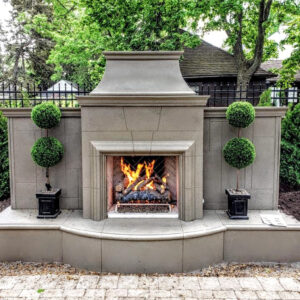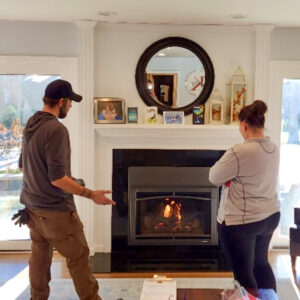Fireplace Conversion: Optimizing Gas Log Placement for Energy Flow
Wood-burning fireplaces are awesome, right? Well, yes and no. Traditional wood-burning fireplaces are timeless and evoke a simpler era, when the fireplace was the centerpiece of the home. It’s where people gathered for warmth, to eat, tell stories, and to spend time together as a family. However, as beautiful and nostalgic as wood-burning fireplaces are, they’re terribly inefficient as heating sources.
Most fireplace owners light fires for special occasions, like Christmas or Thanksgiving, or when they host parties, but rely on their furnaces to keep their homes warm.
If you love the look of a fireplace but want something reliable for heat, a gas fireplace is worth considering. Many homeowners have upgraded their wood-burning fireplace to gas inserts or installed a gas fireplace when building their new home.
Gas fireplaces offer the look of a traditional fireplace while being significantly more efficient as a heating source. However, one factor that gas fireplace owners often overlook is log placement. You see, properly arranged gas logs can improve heat distribution, promote better airflow, and enhance overall comfort. Additionally, it produces a more natural flame that closely resembles the one found in a traditional fireplace.
Let’s look at why gas log placement matters, how to optimize it for maximum comfort, and what to consider when setting up or maintaining your gas log fireplace.
 Why Log Placement Matters
Why Log Placement Matters
Gas log sets are designed to mimic the look and feel of real wood fires. However, unlike wood, which burns from within and radiates heat naturally, gas fireplaces rely on a specific pattern of airflow and combustion. The way your logs are positioned directly impacts how gas flows through the burner, how flames form, and how efficiently heat radiates throughout the room.
Even slightly misplacing the logs can lead to problems, like:
Uneven Heating
Misaligned logs can block heat from spreading evenly, creating hot and cold zones in your living area.
Poor Flame Appearance
Logs placed too close to the burner ports can smother flames, while gaps that are too large can result in an unnatural or sparse fire appearance.
Soot Buildup
Incorrect placement can interfere with combustion, causing incomplete burning and black soot on the logs or glass doors.
Reduced Efficiency
Restricted airflow means less radiant heat and more wasted energy.
When installed and adjusted correctly, gas logs produce a balanced flame pattern that is both beautiful and functional, delivering optimal heat output for maximum comfort.
Getting the Most Out of Your Gas Fireplace
If you’ve recently converted to a gas fireplace or are planning to install one, here are some practical tips to optimize your lot setup for the best possible energy flow and comfort.
Follow the Manufacturer’s Guidelines Closely
Every gas log set is engineered for a specific burner and fuel type—either natural gas or propane. Manufacturers include detailed diagrams that show exactly how to position each log. Even a slight deviation can alter airflow and performance. Before turning on your fireplace, double-check that the logs match the recommended layout for your specific model. They can shift slightly from kids running through the house, heavy traffic on the street, or foundation shifting.
Don’t Block Burner Ports
Burner ports are small openings that release gas and shape the flame pattern. If a log is placed too close or directly over these ports, it can disrupt the flame, resulting in uneven burning or excessive carbon buildup. Ensure each log is positioned just above or behind the flame path, not directly on top of it.
Consider Radiant Heat Reflection
The back wall and floor of your fireplace play an essential role in reflecting heat into the room. Angling the back logs slightly forward and keeping the front logs low can help radiate more warmth outward, rather than letting it rise straight up the chimney. Ceramic or refractory panels can reflect heat more efficiently.
Create Natural Air Channels
Gas fireplaces depend on proper air circulation to maintain a steady flame. Leave small gaps between logs to allow oxygen to feed the fire. Don’t stack or crowd the logs too tightly; natural spacing encourages a more realistic flame and prevents overheating in one area.
When to Call a Professional
You might feel confident enough to make minor adjustments, but professionals are best suited to service gas fireplaces. Certified technicians can inspect the burner alignment and pilot function, ensure proper gas pressure and combustion, reposition logs according to the manufacturer’s recommendations, and check for leaks and soot accumulation.
Call the Gas Fireplace Experts in Motown!
Motown Fire is the go-to fireplace expert in Metro Detroit. Whether you have a gas fireplace, a traditional fireplace, or want a custom outdoor kitchen, we’re the ones to call. Our experienced team means the job is done right the first time. Call us today or stop into our showroom at 50760 Metzen Dr., Chesterfield, MI.




